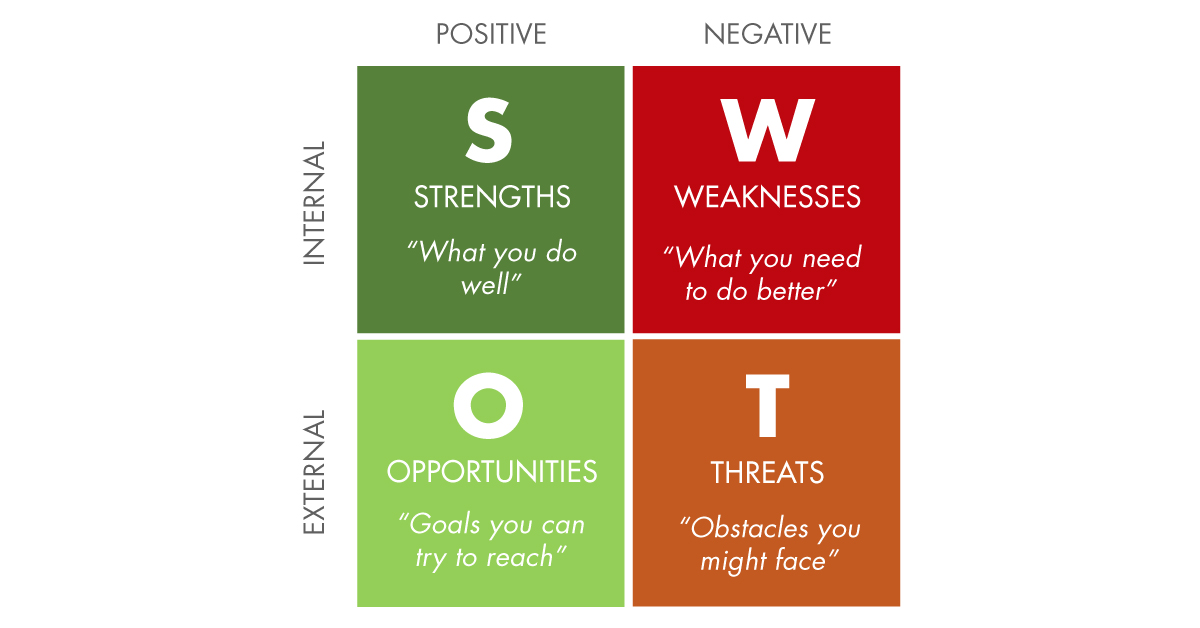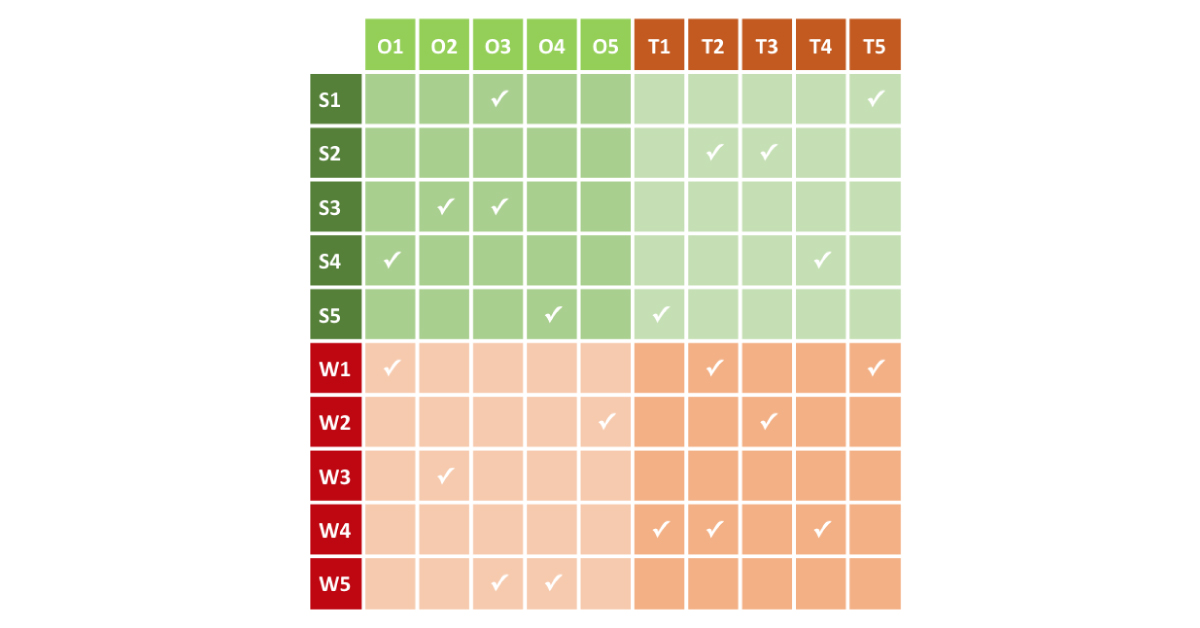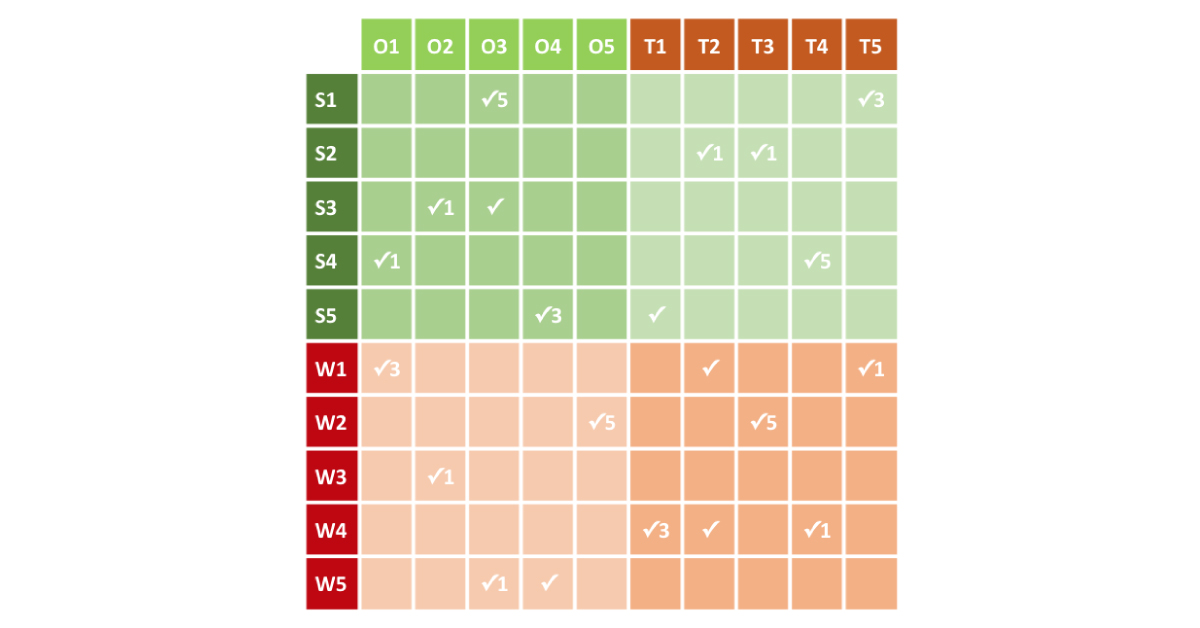SWOT… we’ve all heard of it, we probably seen a few, and maybe we’ve actually made some.
Indeed, a SWOT is a concept or a tool which is widespread – or shall we say vulgarised? – yet very often under-exploited or even improperly-used. In order for it to be effective, a SWOT needs to be dynamic on many levels. But first – as always – let’s start with the basics.
The Cambridge Dictionary defines the word “swot” as a verb, meaning to study hard, usually by reading about or learning something, especially before taking an exam. We naturally see SWOT or S.W.O.T. as an acronym, which it is, but discovering this definition can be seen as an eyeopener, providing a different perspective on the concept.
What is a SWOT analysis?
A SWOT is a tool used to evaluate a business’ position, and perspectives, and as such is a key step to assess and define its strategy. It is like holding up a mirror to the company on the one hand, and scanning its environment on the other. Too often used as a standard reflex or a “tick the box” exercise, a SWOT analysis can only be truly effective if all steps and rules are properly followed, in order to generate genuine value for the business. Check out this video explanation (by Investopedia) as an introduction.
SWOT is an acronym which stands for:
- Strengths
- Weaknesses
- Opportunities
- Threats
These are usually mapped out on a matrix build of 4 quadrants and defined over 2 axes:
- POSITIVE / HELPFUL or NEGATIVE / HARMFUL on the Y-axis,
- INTERNAL vs. EXTERNAL on the X-axis.

This last notion is especially important to understand and implement in order for the SWOT to be effective. Indeed, it is fundamental to distinguish between the items which you can influence, and the ones which are out of your control. Avoiding such confusion makes for a solid foundation of the analysis.
S for STRENGTHS – “What you do well”

Strengths are things that a business does well, and are clearly within its control. These internal factors contribute to the success of a business, and often represent a truly competitive advantage, well beyond industry standards or market requirements. They can be related to technology, resources or skills (team), tangible assets (customer exclusivity, equipment, finances, product USP, …), specific know-how (patents), or even processes like purchasing, production, sales & marketing, logistics, customer service or after-sales.
As much as possible, base the assessment on proven facts rather than perception or opinion, as these can be subject to bias. For example, source the input from customer feedback or 3rd party reviews (press articles, comments on social media, independent reports, …). You can also adopt an outsider view and imagine how your competitors and suppliers view your company or brand and its relative strengths, or – even better – find out directly from them.
W for WEAKNESSES – “What you need to do better”

Weaknesses are inherent shortcomings of the business or the organisation, in absolute terms, or relative to the competition. Past failures, incidents, inefficient practices, lacking resources, customer feedback, press reviews, benchmarks related to products, processes or people. This is definitely the area where taboos are prohibited and honesty must prevail, with a focus on what goes wrong, and why, and not the who.
Weaknesses cover the same areas as strengths (resources, skills, team, location, tangible assets and processes). Even if this is an assessment of the internal performance, consult wherever possible external sources for feedback and evaluations (customer feedback, incident reports, social media reviews, internal audit, etc…).
O for OPPORTUNITIES – “Goals you can try to reach”

Notice the conditional style used… Indeed, opportunities have not yet happened, but they could, so it is about ways to identify what conditions can change positively or what potential is out there… for you to grab or to claim.
Opportunities are positive events arising – now or in the future – outside the company that can contribute to the business : new regulations, technology trends, market developments, changing consumer behaviour, and for which the business has or can have an answer. Hence, it is crucial to continuously have an eye on these external evolutions so your business can anticipate (by changing strategy or tactics) and seize (using existing strengths) these opportunities.
The value of identifying what could happen externally, lies in the internal capacity to anticipate to seize the opportunity when it arises. As opportunities are external, you don’t have any control over these, however any company can and has to control how to respond.
T for THREATS – “Obstacles you might face”

Threats are external factors that can prevent a business from reaching its objectives. They cover similar areas as the opportunities, and negatively affect the business. Threats can include macro-economic factors (inflation, market volatility, recession, climate change, demographic, …), shortage of resources (the current microchip shortage affecting the automotive industry for example, or IT skills on the employment market), policy and regulation (product specifications, like emission standards), competition (new market entrants, technology innovation providing a competitive advantage.
Since threats are by definition outside of the company’s control, identifying them upfront can allow them to anticipate and respond by putting in place the necessary strategies and tactics (like a contingency plan for example).
A clear identification of the threat can provide a competitive edge through anticipation and swift action.
Given the nature of external factors like opportunities and threats, a proper PESTEL analysis can be an effective way to ensure a complete and detailed scan of the various relevant environments.
Why run a SWOT analysis ?
An effective SWOT analysis allows businesses to identify and evaluate all relevant internal and external factors before developing a business strategy or deciding on an action. This applies to all types of companies, big and small, young and old, and can be implemented on overall business strategy (mid-term or annual business plan, pivot), or on specific business decisions like market expansion, product launch, marketing campaign. In order to get a better idea, or even to find some inspiration, you can take a look at these SWOT examples.
A proper SWOT delivers a triple-A result :
- Awareness : by taking a step back, getting a perspective from all angles and all parties involved on your business and its environment (customers, competitors, suppliers and other stakeholders) to provide the best insights
- Analysis : thorough deep-dive into the reasons and implications to identify requirements for (internal) change, either to face threats or to seize opportunities, by leveraging on the strengths and improving on the weaknesses. It is at this stage that the SWOT dynamic clearly comes to life.
- Action : based on the areas of focus that would have surfaced in the analysis, identify actionable roadmaps (objectives or KPI, actions, resources, timing, roles & responsibilities)
The involvement of all relevant stakeholders (management and teams) will insure an effective buy-in and ownership by the whole company. Furthermore, given that the business environment is continuously evolving, the SWOT analysis should be a dynamic exercise repeated and revised at least once a year to ensure its effectiveness.
How to run a SWOT analysis ?
1. Before you start – “the more, the merrier”
Gathering people from all layers and departments of the company will ensure that every function’s view, issues, needs are represented. It will allow to gather different perspectives from within the organisation, and to assess the implications on all teams and functions, building a truly collective awareness. It will also drive involvement throughout the entire SWOT process and ownership of the necessary decisions, responsibilities and actions.
If possible and relevant, you can also involve external stakeholders (distributors, customers, suppliers, …) to get an even more complete perspective on your business.
2. Getting started – “the storm before the silence”
Once the team has been composed, you can set up one or several working sessions each lasting a couple of hours, to ensure the most effective use of the available brain power and creative focus. For the same reason, it is recommended to have all parties in the same, stimulating environment – preferably outside of the usual work setting. Physical presence also tends to create a stronger dynamic and interaction than online meetings.
At this stage, the definition of each component has to be clearly understood, especially the distinction between internal and external – to make the downstream process more efficient.
Ideally, you would set-up 4 break-out sessions of 5 to 10 minutes each during which all contributors will individually think about – or brainstorm – on 1 quadrant of the SWOT. An individual approach in this first stage will prevent interfering, influence or groupthink, and hence will ensure that every participant can express his/her point of view independently.

Instruct the participants to write down 1 item per post-it, using a different colour for each of the 4 quadrants of the SWOT.
At the end of the 4 individual mini storm sessions, gather everyone together, then ask each participant to stick their post-its on a surface (wall, window, board, flip-chart, …) and to provide a short comment on the reasoning behind the item on each post-it. At this stage, you can still allow for participants to produce additional post-its, as discovering other’s input will trigger their own reflection and generate new thoughts.
At this stage, the moderator has a valuable role to ask for clarification, and start placing similar items close to one another – with explicit approval by the participants.
3. Cluster the answers – “great minds think alike”
Once all post-its have been collected and commented on, you can start grouping duplicates, clustering similar items in a way that can highlight similarities or connections. This will narrow down the number of items to address, and regroup several aspects of the same issue or item.
After this step you can actually build your first SWOT matrix – you can find examples of a SWOT template here.

4. Link the SW with the OT – “connecting the dots”
Using the clustered items for each quadrant, the next – and crucial – step is to establish links between Strengths and Weaknesses on one side, and Opportunities and Threats on the other. This is generally a moderated group exercise, and can include “show of hands” type voting to obtain agreement and alignment.
For example, an identified strength allows one to deal with a potential threat, or a certain weakness prevents one from capitalising on a possible opportunity. By doing this, you can establish how to leverage identified internal factors to tackle the acknowledged external factors, establishing a clear connection between both dimensions of the SWOT.
The best way to do this is to create a matrix with all strengths and weaknesses on one axis, and all opportunities and threats on the other axis, then marking the cases to highlight the links. The presence of a mark then indicates visually which external elements you can tackle with which internal factors, hence providing clear areas of focus. On the other hand, the absence of a mark demonstrates that those external elements are largely out of your control, and/or that those internal factors have little or no value for them.
This step is relatively unknown and hence rarely used, yet here lies the true value of any SWOT analysis as an effective tool to drive business decisions. Without this step, the SWOT remains too static, merely providing a status overview and can thus only generate awareness but rarely leads to action.. which is the whole point of exercise, isn’t it ?

5. Score the items – “ten points go to…”
Once all areas of potential focus and action have been identified, you can proceed with a simple scoring in order to rank the retained items. Using the detailed matrix from the previous step (linking), each participant is then allocated a total of 10 points, to be distributed as follows on the marked items in each quadrant : 5 – 3 – 1 – 1. For example, in the quadrant Strengths – Opportunities. Each participant can allocate 5 points to one mark, 3 points to another, and 1 point each to 2 other marks.
Adding up all participants points distributed per quadrant, will give a ranking of the marked items and give an indication of the priorities to pursue. The outcome is of course still open for discussion prior to a “one voice” agreement, and can be subject to arbitration by the management.
The outcome is the basis on which to develop detailed actions plans (1 per item), and should be allocated to an “owner” who can lead the task force including members from other teams, using a typical project management approach, both per items as well as for the overview: KPI / objectives, detailed actions with allocated resources, timings and responsibilities.

Conclusion
The SWOT analysis has proven to be a dynamic and effective tool, however it needs to be used as such in order to provide its true value. Indeed, too often a SWOT comes as a routine “tick the box” brainstorm activity, which doesn’t fully exploit its potential but only provides a static overview without proper deep-dive analysis that generates focused and effective actions.
A SWOT analysis can reach its true value within a genuine strategic process only if it is :
- Dynamic – a collective exercise with all relevant stakeholders, interactive storming exercises, and lively debates to reach agreed conclusions and aligned decisions.
- Effective – fact- based, not opinion-driven, inputs by a wide panel of participants, collective clustering of items and ranking of priorities, full-company buy-in throughout the process
As stated in the introduction of this article, SWOT is indeed a verb, as it requires hard work, individual and collective effort, and learning to boost analysis and drive decisions – only then will it deliver its full value.
Want to learn more about how to create an effective SWOT Analysis that can help define your business? Book a free consultation and let’s chat!


